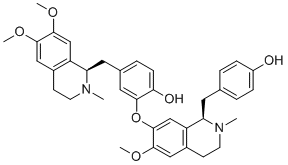Physicochemical Properties
| Molecular Formula | C37H42N2O6 |
| Molecular Weight | 610.7392 |
| Exact Mass | 610.304 |
| CAS # | 2586-96-1 |
| Related CAS # | Liensinine Diperchlorate;5088-90-4;Liensinine perchlorate;2385-63-9 |
| PubChem CID | 160644 |
| Appearance | White to off-white solid powder |
| Density | 1.2±0.1 g/cm3 |
| Boiling Point | 722.0±60.0 °C at 760 mmHg |
| Melting Point | 95-99ºC |
| Flash Point | 390.4±32.9 °C |
| Vapour Pressure | 0.0±2.4 mmHg at 25°C |
| Index of Refraction | 1.618 |
| LogP | 4.84 |
| Hydrogen Bond Donor Count | 2 |
| Hydrogen Bond Acceptor Count | 8 |
| Rotatable Bond Count | 9 |
| Heavy Atom Count | 45 |
| Complexity | 917 |
| Defined Atom Stereocenter Count | 2 |
| SMILES | CN1CCC2=CC(=C(C=C2[C@H]1CC3=CC=C(C=C3)O)OC4=C(C=CC(=C4)C[C@@H]5C6=CC(=C(C=C6CCN5C)OC)OC)O)OC |
| InChi Key | XCUCMLUTCAKSOZ-FIRIVFDPSA-N |
| InChi Code | InChI=1S/C37H42N2O6/c1-38-14-13-26-20-35(43-4)37(22-29(26)30(38)16-23-6-9-27(40)10-7-23)45-33-18-24(8-11-32(33)41)17-31-28-21-36(44-5)34(42-3)19-25(28)12-15-39(31)2/h6-11,18-22,30-31,40-41H,12-17H2,1-5H3/t30-,31-/m1/s1 |
| Chemical Name | 4-[[(1R)-6,7-dimethoxy-2-methyl-3,4-dihydro-1H-isoquinolin-1-yl]methyl]-2-[[(1R)-1-[(4-hydroxyphenyl)methyl]-6-methoxy-2-methyl-3,4-dihydro-1H-isoquinolin-7-yl]oxy]phenol |
| HS Tariff Code | 2934.99.9001 |
| Storage |
Powder-20°C 3 years 4°C 2 years In solvent -80°C 6 months -20°C 1 month Note: This product requires protection from light (avoid light exposure) during transportation and storage. |
| Shipping Condition | Room temperature (This product is stable at ambient temperature for a few days during ordinary shipping and time spent in Customs) |
Biological Activity
| ln Vivo | Similar to metronidazole medications, lenisinine (oral gavage, 100 or 200 mg/kg, once day, 10 weeks) can successfully treat periodontitis in a quantitative dose-dependent manner [2]. |
| Animal Protocol |
Animal/Disease Models: KM mice [2] Doses: 100 mg/kg, 200 mg/kg Route of Administration: po (oral gavage), daily, 10 weeks Experimental Results: Reduce gingival index, increase SOD levels, CAT, GSH-Px levels, diminished levels of NO, MDA and ET compared with controls. Animal/Disease Models: Institute of Cancer Research (ICR) mice (male, 20-22 grams) [3] Doses: Route of Administration: Oral 5 mg/kg; 1 mg/kg intravenous (iv) (iv)administration Experimental Results: The effect of lianxining in mice pharmacokinetic/PK/PK parameters po (5 mg/kg) iv (1 mg/kg) AUC(0-t) (ng/mL*h) 18.8 ± 2.7 211.2 ± 54.9 AUC(0-∞) (ng/mL* h) 19.1 ± 2.8 227.9 ± 60.1 MRT(0-t)(h) 3.2 ± 0.4 2.6 ± 0.5 MRT(0-∞) (h) 3.4 ± 0.5 3.5 ± 0.9 t1 /2z (h) 1.9 ± 0.2 3.8 ± 0.8 CLz/F (L/h/kg) 266.0 ± 41.3 4.7 ± 1.2 Vz/F (L/kg) 708.5 ± 79.9 25.9 ± 11.0 Cmax (ng/mL) 5.3 ± 0.2 169.5±53.5 |
| References |
[1]. A novel autophagy/mitophagy inhibitor liensinine sensitizes breast cancer cells to chemotherapy through DNM1L-mediated mitochondrial fission. Autophagy. 2015;11(8):1259-79. [2]. Protective effect of liensinine on periodontitis through its antioxidant effect in mice. Journal of the Korean Society for Applied Biological Chemistry volume 58, pages927-936. [3]. Pharmacokinetics and bioavailability of liensinine in mouse blood by UPLC-MS/MS. Acta Chromatographica,Volume 33: Issue 4,14 Oct 2020. |
| Additional Infomation |
Liensinine is a member of isoquinolines. Liensinine has been reported in Nelumbo nucifera with data available. |
Solubility Data
| Solubility (In Vitro) | DMSO : ~50 mg/mL (~81.87 mM) |
| Solubility (In Vivo) |
Solubility in Formulation 1: ≥ 2.08 mg/mL (3.41 mM) (saturation unknown) in 10% DMSO + 40% PEG300 + 5% Tween80 + 45% Saline (add these co-solvents sequentially from left to right, and one by one), clear solution. For example, if 1 mL of working solution is to be prepared, you can add 100 μL of 20.8 mg/mL clear DMSO stock solution to 400 μL PEG300 and mix evenly; then add 50 μL Tween-80 to the above solution and mix evenly; then add 450 μL normal saline to adjust the volume to 1 mL. Preparation of saline: Dissolve 0.9 g of sodium chloride in 100 mL ddH₂ O to obtain a clear solution. Solubility in Formulation 2: ≥ 2.08 mg/mL (3.41 mM) (saturation unknown) in 10% DMSO + 90% (20% SBE-β-CD in Saline) (add these co-solvents sequentially from left to right, and one by one), clear solution. For example, if 1 mL of working solution is to be prepared, you can add 100 μL of 20.8 mg/mL clear DMSO stock solution to 900 μL of 20% SBE-β-CD physiological saline solution and mix evenly. Preparation of 20% SBE-β-CD in Saline (4°C,1 week): Dissolve 2 g SBE-β-CD in 10 mL saline to obtain a clear solution. Solubility in Formulation 3: ≥ 2.08 mg/mL (3.41 mM) (saturation unknown) in 10% DMSO + 90% Corn Oil (add these co-solvents sequentially from left to right, and one by one), clear solution. For example, if 1 mL of working solution is to be prepared, you can add 100 μL of 20.8 mg/mL clear DMSO stock solution to 900 μL of corn oil and mix evenly. Solubility in Formulation 4: 20 mg/mL (32.75 mM) in 50% PEG300 50% Saline (add these co-solvents sequentially from left to right, and one by one), clear solution; with ultrasonication (<60°C). Preparation of saline: Dissolve 0.9 g of sodium chloride in 100 mL ddH₂ O to obtain a clear solution. (Please use freshly prepared in vivo formulations for optimal results.) |
| Preparing Stock Solutions | 1 mg | 5 mg | 10 mg | |
| 1 mM | 1.6374 mL | 8.1868 mL | 16.3736 mL | |
| 5 mM | 0.3275 mL | 1.6374 mL | 3.2747 mL | |
| 10 mM | 0.1637 mL | 0.8187 mL | 1.6374 mL |
